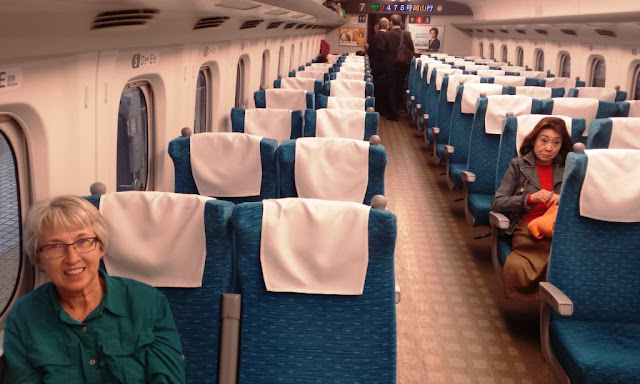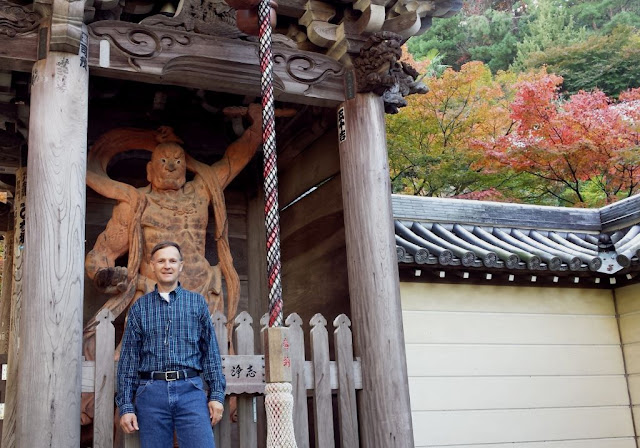This was a perfect opportunity to take a picture of the inside of a shinkansen. With wide comfortable seats and a ridiculously large amount of leg room, it was just what our legs needed after a long day of walking. This would be the least crowded train we would ride on during our 7 days using the pass, so the evening route between Kyoto and Himeji must not be popular on a Monday. Going close to 200 miles per hour with few stops, we arrived in less than an hour.
We were surprised by the number of tunnels we passed through in this section of the country, so obviously many miles of tunnels were drilled for these high speed trains. We arrived in the city of Himeji in the dark, but found our first western style hotel easily. A very new and clean hotel, we have first hand experience that a Japanese double bed is smaller than the beds in the United States. Those beds are also notoriously hard, and the rooms are considerably smaller than we are accustomed to here. We are also finding robes and slippers at each of our stays.
Since we have a refrigerator in our room, we decide to go shopping for early morning breakfast items. That's always an adventure since the packaging is usually opaque and all the writing is in Japanese. We bought a carton of something we hope will be milk, and a bag that we are hoping is granola. But we could have prune juice and kitty litter in the morning for all we know. We also hoped for some English television, but all the channels are in Japanese. This station froze and Denisa took a picture of the screen. Is it interesting to anyone else that the only world in English on the screen is "sports." Is there not a Japanese translation for that word?
The next morning we had a delightful breakfast of fresh fruit, granola and milk (thankfully we guessed correctly), and headed to the train station to catch the shinkansen to Hiroshima. These trains start out so smooth and so fast that they feel like an airplane taking off. We kept waiting for the nose of our train car to turn skyward. We also found that we were going so fast that our ears would feel like they needed to pop as we zipped through long tunnels. These fast trains make in possible to take an easy day trip to a city 200 miles away. If we had to drive a car, it would take almost 4 hours to get here and another 4 hours back today. Instead, we found ourselves in the city of Hiroshima in less than one hour.
Our JR Pass also covered the cost of a sight-seeing bus that circles among the tourist stops in Hiroshima. We got off at the stop for the Atomic Bomb Memorial. The bomb exploded 600 meters above this building, and its skeleton was slated to be torn down. But it was saved as a memorial, and is now on the World Heritage list.
We walked across the bridge, and into the peace memorial park across the river. One of the memorials was in honor of the children that died as a result of the explosion. It was inspired by a little girl exposed to the radiation, who died ten years later of leukemia.
Just down the walkway is the "Flame of Peace." If you look carefully in the silver ring, you can see a yellow flame that will only be extinguished when the last nuclear weapon on earth is destroyed.
The flame and the dome are framed by the arch-shaped cenotaph memorial which contains the names of all the known victims of the bomb.
The park was beautiful in its fall colors, and kept tidy by the army of sweepers that we have seen all over Japan.
Adjacent to the park is the Peace Memorial Museum. The 50-cent ticket was a small token for a big experience. Many of the exhibits showed tattered remains of clothing, lunch boxes, watches, etc. worn at the time the bomb exploded on August 6, 1945. Many of the items were worn by the 6,300 junior high children that had been dismissed from school and assigned to do building demolition for fire breaks for the military. They just happened to be working in that area when the bomb was dropped. Thousands more of the victims were Koreans that the Japanese had forced to work for them. This map inside the museum shows the destruction of the area seconds after the bomb (symbolized by the red ball) exploded. Everything was leveled except a few well-built buildings.
It was a sobering morning spent in a country whose citizens still feel the effects of the radiation and horror of that day. But it was a beautiful day, so we next headed on a slower local train from Hiroshima train station to the port city of Miyajima. Our Japan Rail Pass also covers the cost of a ferry ride from the mainland to the island.
As we approached the island, we got our first glimpse of the floating vermilion Torii gate that the guidebook boasts is one of the three best views in Japan.
The closer view from the shore seemed more picturesque, complete with a boat loaded with tourists that paid to get an even closer look at the Torii gate.
The welcome committee was headed by a samurai warrior that looked a little sinister in his black gear. He was actually in costume, and for a price you could take a photo with him.
Just like in Nara, this island is home to a herd of tame deer.
These innocent looking deer can be pretty sneaky. We watched as one swiped a magazine, and another ate the wrapper from a sandwich from unsuspecting tourists.
We ate our shrimp and avocado pizza on the patio of a restaurant, watching the deer harass the tourists, and looking over the ocean. Our pizza was great, but the longest line on the island was at the grilled oyster cafe. We also saw plenty of people eating squid and eel on a stick. Our favorite snack of the day was a maple leaf shaped pastry filled with chocolate fudge.
We watched the totally automated machine through the window as it buttered the pan, pumped in the batter, plopped in the fudge, covered with more batter, then baked in the leaf mold. We could even see the arm snatch the cakes out of the pans and send them on to the automatic packager.
That warm pastry with a fudgy center might make us change our opinion that the Japanese don't know how to make a good dessert. Denisa even enjoyed her cup of green tea with it. But we have already learned that some pastries we assumed to be filled with delicious chocolate are actually not-so-delicious red bean paste.
We have also found that any beautiful setting will have several temples and shrines. Even though we have already seen our quota of both, we must say that they make beautiful backdrops for the fall foliage we are enjoying. This is the Daishoin Temple on Miyajima Island.
On the stairs leading up to the temple was a long line of cylinders with Japanese writing on them. Worshipers would spin the cylinders as they climbed up the steps. We're sure there is a formal Japanese name for these, but we just called them "holy rollers."
We took a picture of another set of holy rollers with their surrounding trees.
The entrance of the temple was guarded by a wild-eyed guy, as well as a statue.
Someone had spent a lot of time crocheting individual caps for the stone statues in the garden.
This is not all of them, so there were lots of heads to cover. The next picture can be used for a game of "spot the green beanie" among all those bald heads. There were bowls in front of them, with offering coins inside.
There was another group of statues that had been clothed as well. They also had a place for coin offerings.
There were other statues in the area, and Mark was feeling pretty good about the size of his nose after spending some time with this guy.
We also went into the cave, made bright with hanging lights and 88 shikoku images.
Now we are in Momiji-dani-koen. Momiji is the Japanese word for maple and koen is their word for park. There were beautiful displays of maple color all over this park.
More orange paint has been used on this shrine higher into the mountains.
Taho-to is the name of its matching picturesque pagoda.
We wandered around the streets filled with shops and little restaurants. We are always shopping for a cross from Japan, but didn't expect to find one on this tiny island with so many Buddhist temples and Shinto shrines. But we did find the world's largest shakushi (rice scoop) instead.
We have been doing lots of urban walking, but very little hiking this month. So we headed towards Mt. Misen on a trail lined with nice fall foliage.
Mt. Misen is the highest point on the island, and the trail up is like a never-ending stairmaster. The exercise has warmed Denisa up now.
The viewpoint from our hike gave a postcard picture of the port and that Torii gate far below.
We made our way back to the port, and Denisa noticed a woman with a bag of small oranges. We had been looking for fresh fruit, but had missed the fruit stand on the island. When we asked her for directions to the fruit, she pointed and let us know that it was far away. When we acted disappointed with the distance, she reached into her sack and got out three oranges. She insisted that we take them. It was just another example of the generous spirit of the Japanese people.
The sun was setting as our boat pulled in to transport another group of tourists off the island.
This is a wonderful excursion and a beautiful sky to send us home.
After the ferry ride, there was another local train ride back to the city. This sounds like the end of the day, but Denisa had heard that Hiroshima was famous for a savory pancake known as Okonomiyaka. It usually includes cabbage, noodles, pork, onions, and egg that are piled together and grilled. It is sandwiched between two thin pancakes when served.
Not all that attractive, it was pretty tasty and nutritious. Big enough to share, it was a good value for dinner tonight. We can report that we are getting better with our chopsticks every day.
After our one-hour trip on the shinkansen back to Himeji, our legs were rested and we were ready for a walk around the city where we were staying. This city is famous for its beautiful castle, and we're heading there tomorrow. But tonight we walked the short 2 mile trip downtown to get a shot of the castle lit up at night. There'll be far too many pictures of it when we take the tour to visit it tomorrow.










































No comments:
Post a Comment